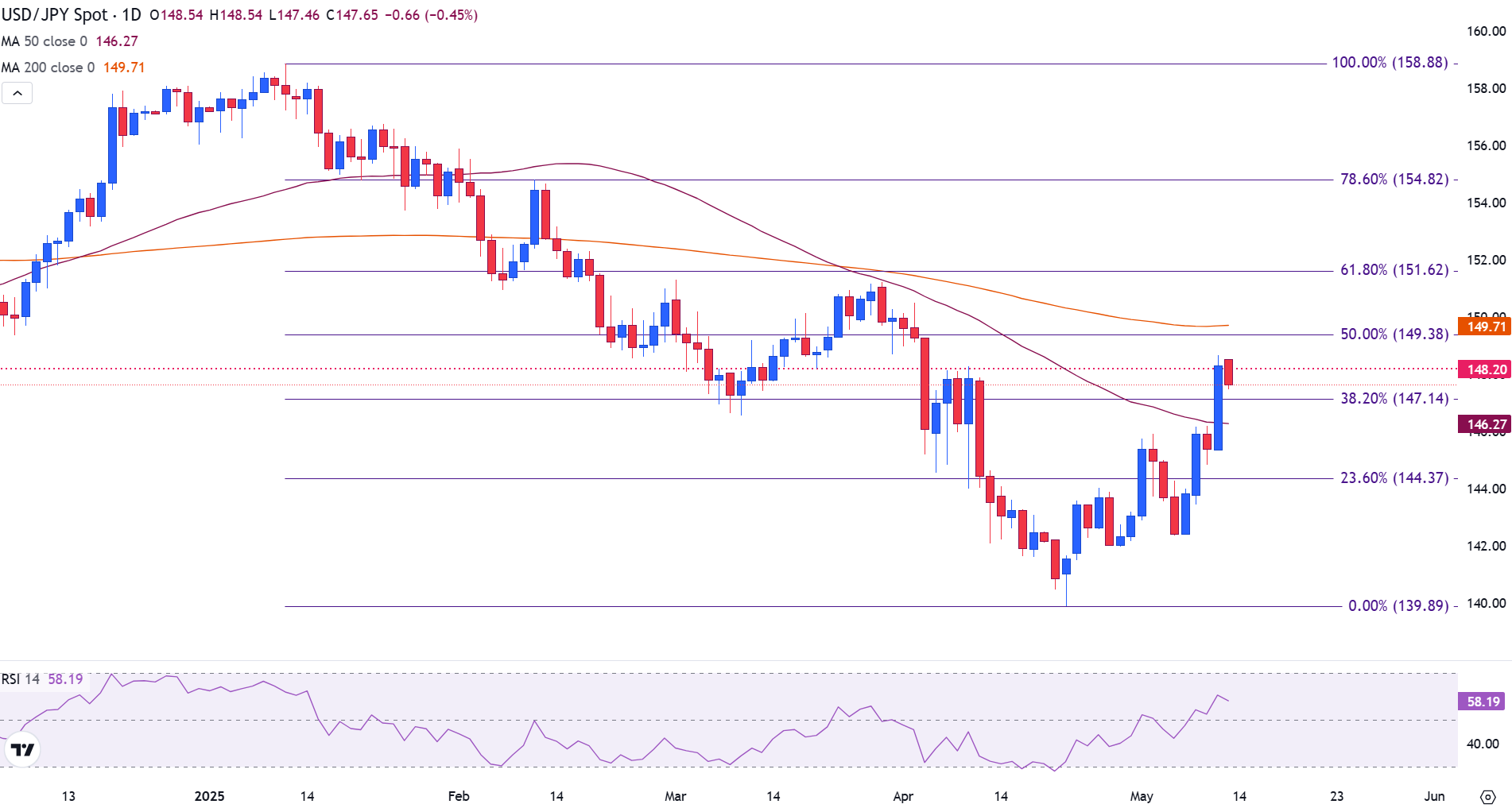USD/JPY slips below 148.00 as US inflation slows, Fed rate cut bets firm
- USD/JPY drops below 148.00 as softer US CPI data fuels a dovish shift in Fed rate expectations.
- US Dollar loses ground as Treasury yields fall; traders weigh rate cut prospects against cautious BoJ outlook.
- Markets await Fed speeches and Japan data, including PPI on Wednesday and GDP on Friday, for further direction.
The Japanese Yen (JPY) is advancing modestly against the US Dollar (USD) on Tuesday as softer-than-expected US inflation data reignited speculation about Federal Reserve (Fed) rate cuts later this year.
At the time of writing, USD/JPY is down 0.43% on the day, trading below 148.00 after failing to extend Monday’s rally fueled by improved global risk sentiment and easing trade tensions.
The move follows Monday’s sharp rebound, which had been driven by optimism surrounding a temporary truce in US–China tariffs. However, the upbeat mood was tempered by the US Consumer Price Index (CPI) report, which showed inflation slowing more than anticipated and weighed on the US Dollar.
US CPI miss rekindles dovish Fed outlook
The April US CPI report revealed a moderation in inflationary pressures. Headline CPI rose by just 0.2% (MoM), missing the 0.3% forecast and rebounding from March’s -0.1% decline.
On an annual basis, inflation cooled to 2.3%, below the expected 2.4%.
Core CPI—which strips out volatile food and energy prices—also increased by 0.2% MoM, underperforming the 0.3% consensus and holding steady at 2.8% YoY.
The data has bolstered market confidence that the Federal Reserve could begin cutting interest rates later this year. According to the CME FedWatch Tool, traders are now pricing in a 25 basis point rate cut in September with increased conviction.
Focus shifts to Fed speakers and Powell's Thursday address
The downside surprise in inflation has renewed pressure on the US Dollar, with USD/JPY stalling after Monday’s gains.
Investors are now turning their attention to a series of speeches from key Fed officials.
On Wednesday, Governors Christopher Waller, Philip Jefferson, and Mary Daly are scheduled to speak, followed by Chair Jerome Powell’s remarks on Thursday. Markets will be watching closely for any dovish tilt that may further support expectations for policy easing.
Japanese Yen supported by yield adjustment, cautious BoJ outlook
The Japanese Yen gained modest ground as US Treasury yields edged lower in response to the CPI report. A narrower interest rate differential reduces the appeal of USD/JPY carry trades, offering some support to the Yen.
However, the upside remains limited due to the Bank of Japan’s (BoJ) persistently accommodative stance. Without clear signals of tightening from the BoJ, JPY gains may be capped.
Key Japanese data releases are ahead, including PPI and GDP
Investors are also eyeing Japan’s economic calendar. The Producer Price Index (PPI) is due on Wednesday, with forecasts pointing to a 4.0% YoY increase in April, slightly down from March’s 4.2%. A softer print could ease inflation pressures and reduce the case for BoJ tightening.
Attention will then shift to Japan’s Q1 Gross Domestic Product (GDP) release on Friday. Economists expect a 0.1% QoQ contraction following a 0.6% gain in Q4 2024.
A sharper slowdown may dampen expectations for a BoJ rate hike this year, while a surprise upside could offer fresh support for the Yen.
Key resistance at 148.00 holds as bullish momentum pauses below Fib confluence
USD/JPY pulled back on Tuesday after failing to clear the 148.20 level, the mid-point of the YTD move.
This zone has consistently acted as both resistance and support, capping gains in late March and triggering price reactions in early April, marking it as a significant technical pivot.
At the time of writing, the pair is trading near 147.62, holding just above the 38.2% Fibonacci retracement level at 147.14, drawn from the January high of 158.88 to the April low of 139.89.
The 50-day Simple Moving Average (SMA) at 146.27 provides the next layer of dynamic support, reinforcing the short-term bullish structure. Meanwhile, the Relative Strength Index (RSI) has eased to 58.07, indicating that bullish momentum remains intact, though no longer in overbought territory.
USD/JPY daily chart

Japanese Yen FAQs
The Japanese Yen (JPY) is one of the world’s most traded currencies. Its value is broadly determined by the performance of the Japanese economy, but more specifically by the Bank of Japan’s policy, the differential between Japanese and US bond yields, or risk sentiment among traders, among other factors.
One of the Bank of Japan’s mandates is currency control, so its moves are key for the Yen. The BoJ has directly intervened in currency markets sometimes, generally to lower the value of the Yen, although it refrains from doing it often due to political concerns of its main trading partners. The BoJ ultra-loose monetary policy between 2013 and 2024 caused the Yen to depreciate against its main currency peers due to an increasing policy divergence between the Bank of Japan and other main central banks. More recently, the gradually unwinding of this ultra-loose policy has given some support to the Yen.
Over the last decade, the BoJ’s stance of sticking to ultra-loose monetary policy has led to a widening policy divergence with other central banks, particularly with the US Federal Reserve. This supported a widening of the differential between the 10-year US and Japanese bonds, which favored the US Dollar against the Japanese Yen. The BoJ decision in 2024 to gradually abandon the ultra-loose policy, coupled with interest-rate cuts in other major central banks, is narrowing this differential.
The Japanese Yen is often seen as a safe-haven investment. This means that in times of market stress, investors are more likely to put their money in the Japanese currency due to its supposed reliability and stability. Turbulent times are likely to strengthen the Yen’s value against other currencies seen as more risky to invest in.

